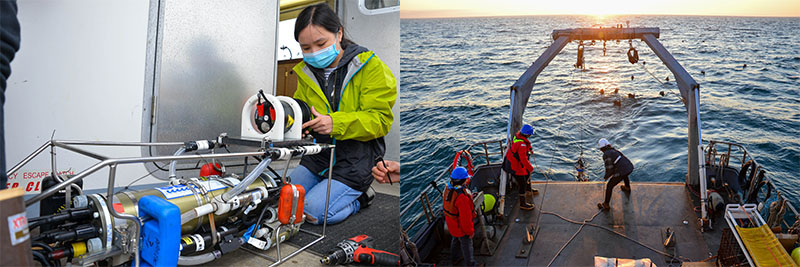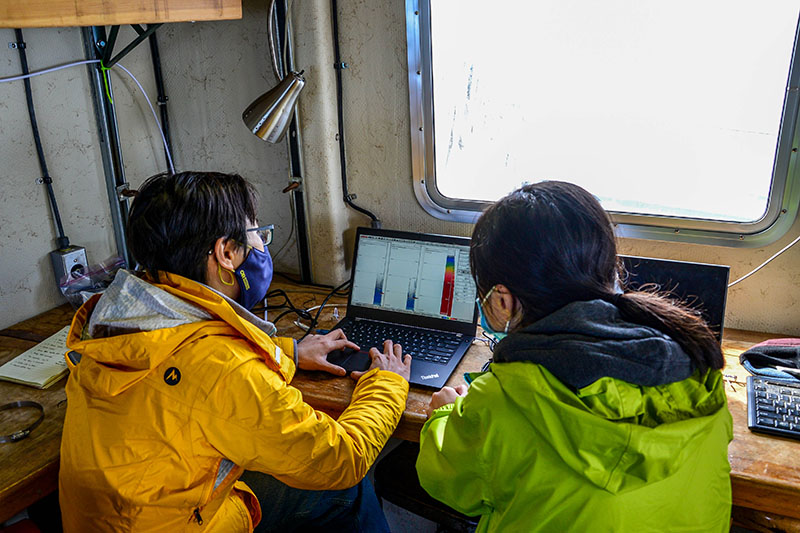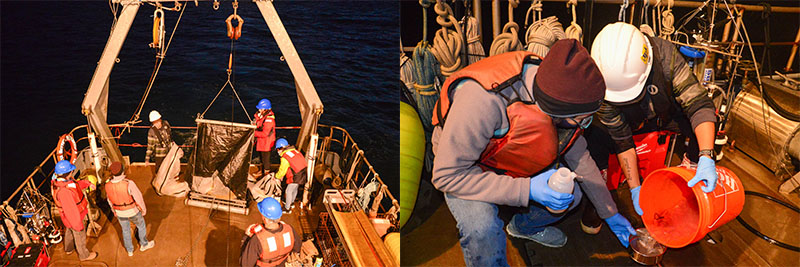
Saturday, August 28, 2021
Early this morning, the expedition team greeted the foggy Olympic Coast while they prepared for their first day at sea. After all this preparation, a buzz of excitement was in the air.
The science team had four objectives for the day: (1) deploy an acoustic Doppler current profiler (ADCP)-equipped Seaglider; (2) cast a CTD (conductivity, temperature, and depth) instrument furnished with an ADCP to measure salinity, oxygen, pressure, and temperature; (3) collect acoustic backscatter data from an echosounder mounted on Research Vessel (R/V) Robertson; and (4) conduct zooplankton net tows. With an overall mission goal to ground-truth the utility of ADCP-equipped Seagliders for studying zooplankton and small fish, all of these data streams will come together to assess Seaglider’s ability to meet its scientific objectives.
This Seaglider has just gotten a complete makeover to its hydraulics system, which is a big deal in glider engineering. Deployment will be nerve-wracking for engineers Christina Ramirez and Kira Smith, but they are hopeful that this will be a big win for the science team. Once at site, Seaglider is hoisted into the air by R/V Robertson’s crane (Figure 1). Upon receiving the green light from on-shore glider pilot Geoff Shilling, Christina releases Seaglider into the depths of the North Pacific. While the glider slips away with its antenna peeking above the surface, the team momentarily holds their breath. Christina is in constant communication with Geoff who confirms the glider is flying nicely – success! The team will not see this glider again for another month.

Figure 1: (Left) An acoustic Doppler current profiler (ADCP)-equipped Seaglider. The ADCP is the circular instrument in the middle of the glider. The orange antenna allows the Seaglider to transmit its data and position when it comes to the surface. (Right) The Seaglider is deployed by engineers Christina Ramirez and Kira Smith offshore of La Push, Washington. Image courtesy of Coordinated Simultaneous Physical-Biological Sampling Using ADCP-Equipped Ocean Gliders. Download largest version (jpg, 5 MB).
Next on the to-do list is the CTD cast (Figure 2). While Christina and Kira prepare the CTD, research assistant Linda Nguyen completes her final checks on the ADCP that she will mount to the CTD. Using the ship’s winch system, captain Eric Boget controls the CTD’s depth ranges after it is lowered into the water. All the while, Seaglider dives 0.5 miles away, collecting critical acoustic backscatter data.

Figure 2: (Left) Research assistant Linda Nguyen attaches an acoustic Doppler current profiler (ADCP) to the CTD (conductivity, temperature, and depth). This ADCP will be used to collect acoustic backscatter data on the small organisms in the water column. (Right) The CTD is recovered using Research Vessel Robertson’s winch system as curious black-footed albatrosses watch from the water. Image courtesy of Coordinated Simultaneous Physical-Biological Sampling Using ADCP-Equipped Ocean Gliders. Download largest version (jpg, 6.8 MB).
Traditionally, acoustic data is collected using ship-mounted echosounders, like the one that principal investigator Wu-Jung Lee has affixed to the bottom of R/V Roberstson. To gather this data in real time, Wu-Jung and Linda turn on the echosounders and station in front of their computers (Figure 3). They are excited about what they see – aggregations of krill and hake. This is crucial to help Wu-Jung prepare for deploying the final acoustic data collection instrument, a moored echosounder, that will sink to the seafloor in the vicinity of Seaglider. Upon returning to shore this evening, Wu-Jung will run statistics on these data to make the final determination of where the moored echosounder will be dropped tomorrow.

Figure 3: Principal investigator Wu-Jung Lee and research assistant Linda Nguyen analyze the data coming in from the ship’s mounted echosounder. The graphs on their screens are called echograms and can be used to identify layers of small organisms in the water column. Image courtesy of Coordinated Simultaneous Physical-Biological Sampling Using ADCP-Equipped Ocean Gliders. Download largest version (jpg, 2.7 MB).
While the sun sets, a zooplankton tow net (Figure 4) is cast to collect specimens that will help identify the organisms seen in the acoustic backscatter data. Marine biologist Jennifer Hagen is particularly excited about this part of the day as her work focuses on monitoring the marine resources off La Push, which zooplankton are an important part of.
It has been a long day, but the team are in good spirits. As captain Andy Ellers points R/V Roberston back towards La Push, everyone can rest easy knowing that they accomplished all the day’s goals.

Figure 4: (Left) The team prepares the zooplankton tow net at dusk. Each night, zooplankton migrate to the water’s surface to feed on phytoplankton, making dusk the perfect time to use nets to collect samples. This is often referred to as “the greatest migration on Earth” as it happens in all ocean basins around the world. (Right) The zooplankton from the nets are collected in jars to be analyzed later under microscopes. Image courtesy of Coordinated Simultaneous Physical-Biological Sampling Using ADCP-Equipped Ocean Gliders. Download largest version (jpg, 7.5 MB).
Published August 30, 2021